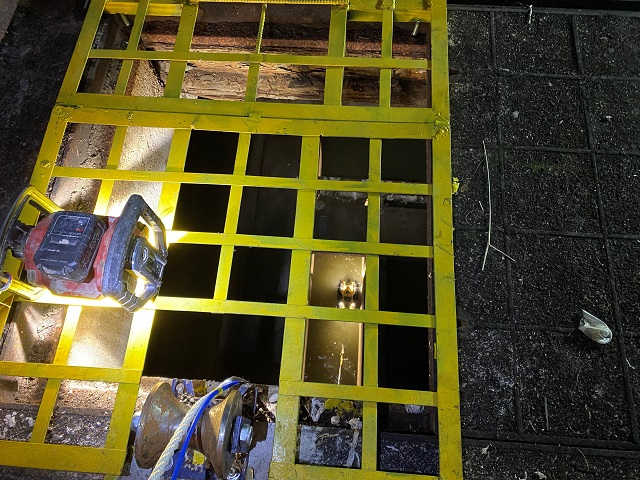DSD brings in new technologies to drainage system maintenance works
29 March 2022
A spokesman for the Drainage Services Department (DSD) said today (March 29) that under the impacts of climate change, heavy rainfall due to extreme weather will become more frequent. In order to enhance the overall drainage capacity of Hong Kong, the DSD will strive to adopt new technologies to improve the efficiency and safety of the maintenance works for drainage facilities.
The spokesman said the DSD has received 90 flooding reports last year, similar to the average over the last five years. A total of eight tropical cyclones necessitated the issuance of tropical cyclone warning signals; also two black, six red and 27 amber rainstorm warning signals were issued last year, more than the recorded annual average.
Analysis of the flooding reports revealed that the majority of flooding cases were caused by the blockage of drainage intakes by debris such as leaves, sand, gravel or waste, which affected the discharging of surface runoff. Also, part of the flooding cases were the result of tidal caused backwater in low-lying areas. Most of the flooding cases subsided immediately after emergency clearance works carried out by the DSD. The DSD will also conduct investigation of particular flooding cases when necessary and take appropriate measures.
The spokesman appealed to the public to keep drains clear at all times and prevent the blocking of drainage intakes. The public should immediately call the 24-hour Drainage Hotline at 2300 1110 if abnormalities with the public drainage facilities are found.
To further reduce flooding risk, regular maintenance is necessary for drainage facilities such as river channels and underground pipes. However, maintenance works for drainage facilities are easily affected by weather conditions and tide levels. In addition, limited working spaces in most of the underground drainage facilities constrained the use of large machinery, posing safety risks for workers. In view of the above, the DSD continues to adopt new technologies including the use of a river desilting robot and a remotely operated pipeline inspection robot to assist in the maintenance works.
The spokesman said, "The DSD brought in the river desilting robot in December last year which desilted a section of Tuen Mun River underneath Tuen Mun Station (operation video). The robot collects silt by suction, which is similar to the operation of a vacuum cleaner. The operator remotely controls the robot on a temporary working platform via a console. The silt is located by the closed-circuit television and sonar device installed on the robot and dewatered at the temporary dewatering tank before it is transferred off site."
Compared with the traditional desilting method which requires operators to drive excavators and trucks into the river, the river desilting robot can operate under water and is not affected by tides and weather. As a result, desilting works can be carried out throughout the year, making desilting operations more flexible and efficient. The larger suction rate of the river desilting robot allows it to collect more fluid silt as compared with the desilting robot used at box culverts, making it more suitable for the desilting works at rivers.
The DSD has also piloted a remotely operated pipeline inspection robot to assist in the investigation of the structural integrity and service condition of underground drains, which helps with the maintenance and upgrading of drainage systems in a timely manner. The pipeline inspection robot is a vessel equipped with a 360-degree high-definition camera and a sonar device. The robot can operate within a drain remotely without flow diversion. The data collected can help with the formulation of desilting and maintenance works. The high-definition camera is used to inspect the condition of the pipeline structure above water level, and the sonar device is used to detect the profile of the siltation.
The pipeline inspection robot completed an inspection with CCTV and sonar of a 1.8-kilometres sewage tunnel in Tseung Kwan O on January 15 this year, breaking the record in Hong Kong.
The spokesman said, "The river desilting robot and the pipeline inspection robot can greatly reduce the safety risk of workers by remote operation. The DSD expects the applications of such technology can be further extended to the maintenance works of other rivers and pipelines upon the gathering of data and experience from these trials."
The relevant article was published on HKSAR Government Press Releases:
https://www.info.gov.hk/gia/general/202203/29/P2022032800227.htm
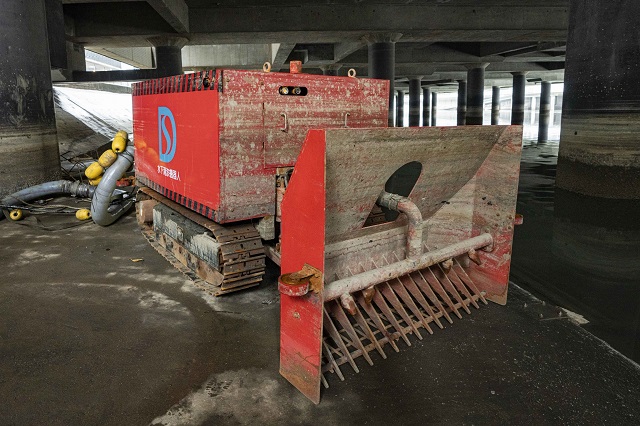
The Drainage Services Department (DSD) strives to adopt new technologies to enhance the efficiency and safety of the maintenance works for drainage facilities. Photos shows the river desilting robot recently procured by the DSD.
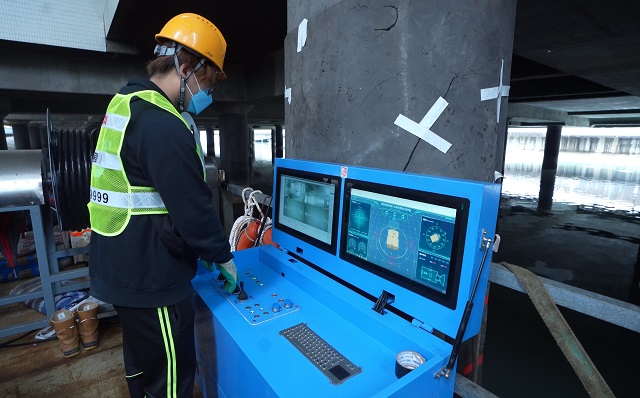
The Drainage Services Department (DSD) strives to adopt new technologies to enhance the efficiency and safety of the maintenance works for drainage facilities. Photo shows the operator remotely controlling the river desilting robot from the working platform.
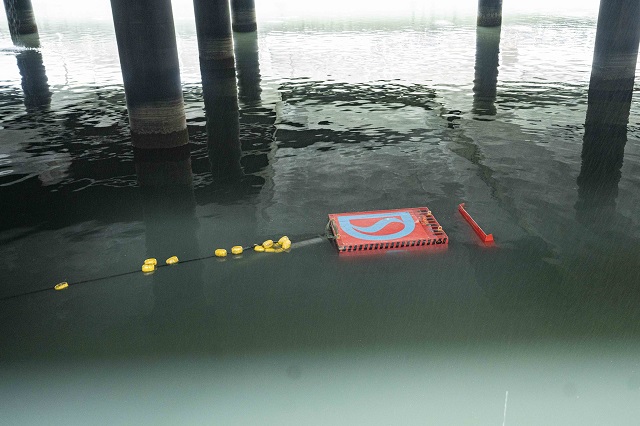
The Drainage Services Department (DSD) strives to adopt new technologies to enhance the efficiency and safety of the maintenance works for drainage facilities. Photo shows the river desilting robot working in Tuen Mun River.
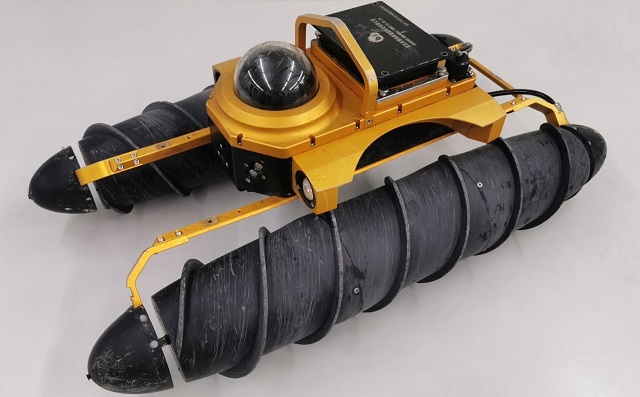
|
The Drainage Services Department (DSD) strives to adopt new technologies to enhance the efficiency and safety of the maintenance works for drainage facilities. Photo shows the remotely operated pipeline inspection robot recently procured by the DSD. |
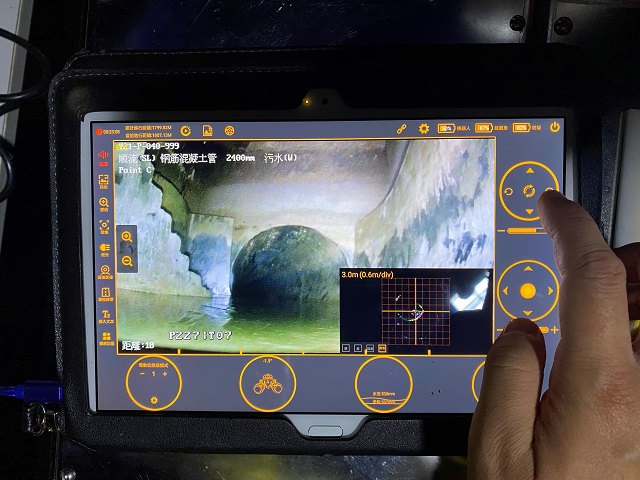
The Drainage Services Department (DSD) strives to adopt new technologies to enhance the efficiency and safety of the maintenance works for drainage facilities. Photo shows the camera and sonar system of the pipeline inspection robot, which enables the operator to remotely inspect the condition of the pipeline structure.
|
|

